Carving na sněhu je o plynulých, kontrolovaných zatáčkách pomocí hran vašich lyží nebo skiskates. Není to jen pro profíky – každý se to může naučit s vhodným vybavením a technikou. Krátké lyže jako Snowfeet* usnadňují zvládnutí carvingu, protože jsou lehké, citlivé a fungují s běžnou zimní obuví. Tady je, co potřebujete vědět:
- Proč krátké lyže fungují: Kratší délka znamená snadnější ovládání, rychlejší zatáčky a menší námahu ve srovnání s dlouhými lyžemi.
- Výhody Snowfeet*: Kompaktní, přenosné a vhodné pro začátečníky, usnadňují učení a fungují na svazích, stezkách i místních kopcích.
- Jak začít: Zaměřte se na postoj těla – pokrčená kolena, vyvážená váha a zapojené hrany. Procvičujte plynulé S-tvarované zatáčky pro získání jistoty.
- Možnosti vybavení: Modely sahají od 15palcových ski skates (150 $) pro začátečníky až po 47palcové krátké lyže (690 $) pro pokročilé jezdce.
- Údržba: Udržujte hrany ostré, voskujte skluznici a kontrolujte vázání pro hladkou jízdu.
Chcete carving jako profík? Začněte pomalu, cvičte a nechte kratší, obratnější lyže odvést těžkou práci. Snowfeet* dělají carving zábavným, efektivním a dostupným pro všechny úrovně dovedností. Vyrazme na svah!
JAK CARVOVAT NA LYŽÍCH JAKO PROFÍK | 3 tipy a cviky na carving pro lyžaře středně pokročilé až pokročilé úrovně
Jak funguje carving s krátkými lyžemi a skiskates
Carving je o naklánění lyží, aby vznikly hladké, čisté oblouky ve sněhu - žádné smýkání, žádné škrábání. Kouzlo spočívá v bočním výbrusu, což je zakřivený okraj lyže. Tento tvar přirozeně vede vaše zatáčky, díky čemuž carving působí téměř bez námahy, když je proveden správně.
Právě zde krátké lyže ukazují svou sílu. Díky hlubším bočním výbrusům a kratší délce se mnohem snáze ovládají ve srovnání s delšími lyžemi. Představte si to jako řízení kompaktního auta oproti dlouhému nákladnímu vozu - krátké lyže reagují rychleji a poskytují rychlejší kontrolu. To je skvělá volba pro každého, kdo chce carving provádět s přesností.
Delší lyže, jako ty od Rossignol nebo Atomic, vyžadují více svalové síly a technických dovedností k udržení carvingového oblouku. Jsou navrženy pro lyžaře, kteří jsou připraveni vynaložit úsilí. Na druhou stranu, krátké lyže a skiskates, jako Snowfeet*, jsou lehké a velmi citlivé. Reagují okamžitě na vaše pohyby, což je činí uživatelsky přívětivějšími. Navíc fungují s vašimi běžnými zimními botami, takže můžete vynechat objemné lyžařské boty, které často narušují rovnováhu.
Myšlenka je jednoduchá: kratší lyže vyžadují méně úsilí k řízení a manévrování. To znamená, že se můžete soustředit na zlepšení své techniky, přičemž každý malý posun váhy a úhel hrany vám pomáhá budovat svalovou paměť pro hladší a kontrolovanější carving.
Co dělá Snowfeet* odlišnými
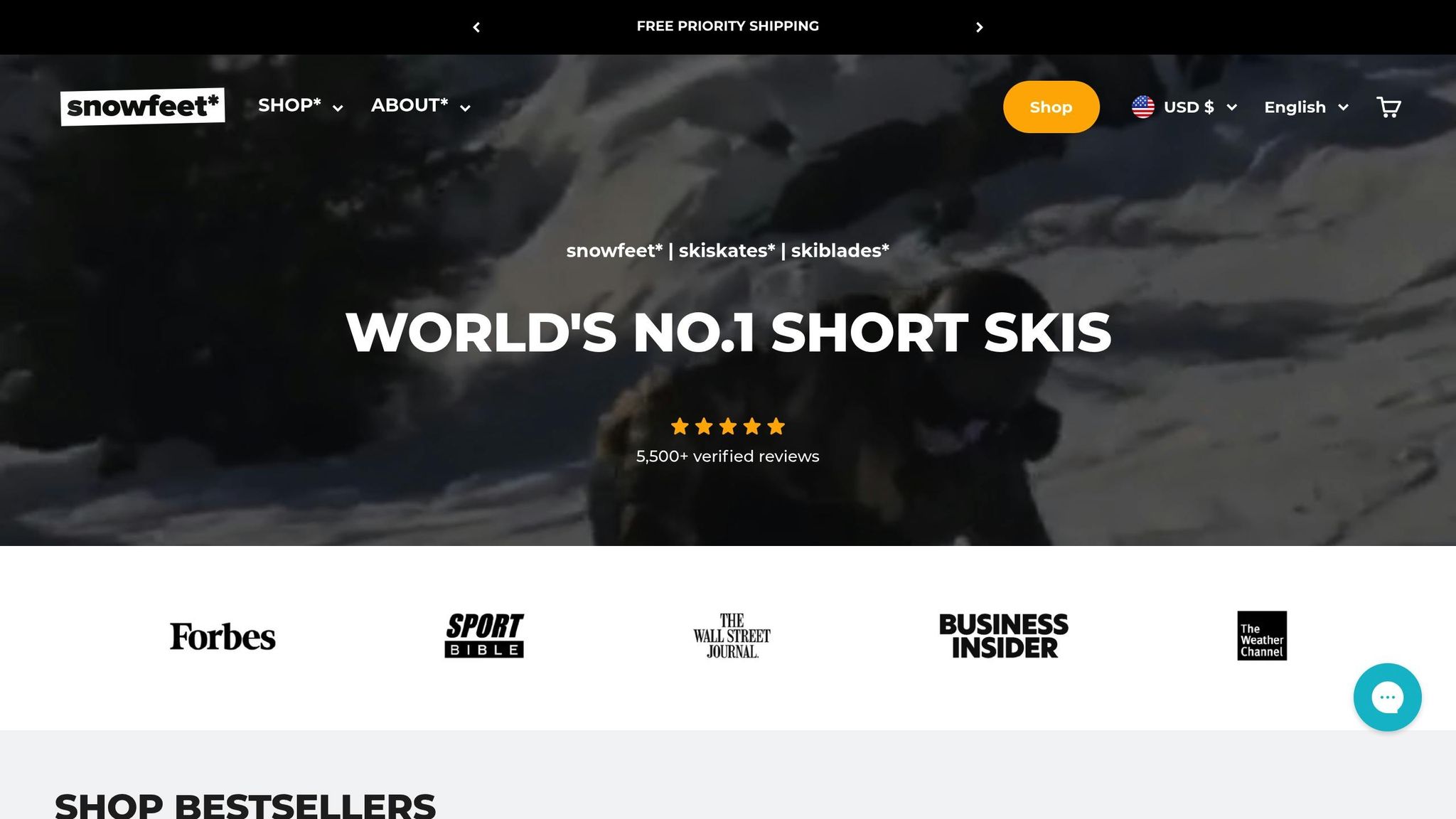
Produkty Snowfeet* přinášejí svěží nádech do carvingu. Na rozdíl od tradičních skiskates, které často používají konstrukci s dřevěným jádrem jako běžné lyže, jsou Snowfeet* vyrobeny z lehkého, odolného plastu. Tento materiál je nejen snadno ovladatelný, ale také dostatečně pevný, aby vydržel.
Snowfeet* jsou k dispozici v délkách od 15 palců do 47 palců, což je výrazný kontrast k délce 63-71 palců většiny dospělých lyží od značek jako Head nebo Elan. Například Snowfeet* Mini Ski Skates jsou dlouhé jen 15 palců (38 cm), zatímco jejich nejdelší model - Short Skis - měří přibližně 47 palců (120 cm). Tento rozdíl v délce usnadňuje ovládání, zejména pro začátečníky nebo kohokoli, kdo hledá obratnější lyžařský zážitek.
"Krátké lyže jsou velmi lehké a dělají lyžování velmi snadným a zábavným" - Tým Snowfeet
Další výraznou vlastností je všestrannost. Na rozdíl od tradičního lyžařského vybavení, které je často omezeno na upravené sjezdovky, Snowfeet* fungují téměř kdekoli - na svazích, ve snowparcích, na turistických stezkách nebo dokonce na sousedském kopci.
Jejich široký základ přidává stabilitu, což je obrovské plus, když se učíte udržovat rovnováhu na hranách během carvingových oblouků. Naopak tradiční dlouhé lyže mají větší plochu, což může vytvářet větší tření a vyžadovat více úsilí k dosažení dokonalé hrany. Design Snowfeet* dělá carving jednodušší a přístupnější, čímž se odlišují od tradičních lyží a snowboardů.
Snowfeet* vs tradiční dlouhé lyže a snowboardy
Když porovnáte Snowfeet* s tradičními lyžemi nebo snowboardy, rozdíly jsou jasné. Dlouhé lyže od značek jako Atomic, Head a Elan mohou být pro začátečníky zpočátku snazší na udržení rovnováhy, ale zvládnutí jejich techniky je úplně jiný příběh. Vyžadují značnou sílu nohou a přesné pohyby, zejména na strmém nebo zledovatělém terénu. Prodloužený kontakt hrany u dlouhých lyží přidává stabilitu, ale také zvyšuje odpor, což dělá oblouky náročnějšími.
"Postoj na krátkých lyžích je přirozenější než na dlouhých lyžích a proto méně namáhavý" - Tým Snowfeet
Snowfeet* mění pravidla hry. Jejich krátká délka dělá křivku učení mnohem plynulejší. Nemusíte vynakládat tolik úsilí na každý oblouk - stačí přesunout váhu a naklonit se, a lyže udělají zbytek. Je to intuitivnější a méně vyčerpávající způsob carvingu.
Další velkou výhodou Snowfeet* je přenosnost. Tradiční lyžařské vybavení přináší spoustu zavazadel - speciální boty, vázání, hole a starosti s jejich přepravou. Snowfeet* fungují s vašimi běžnými zimními botami a jsou dostatečně kompaktní, aby se vešly do batohu. Můžete vyrazit na svůj oblíbený kopec a začít carving během několika minut.
"Točení je nejdůležitější dovedností při lyžování a kratší lyže usnadňují proces učení" - Tým Snowfeet
Zatímco snowboardy mohou díky své vztlakové síle lépe fungovat v hlubokém prašanu, přinášejí s sebou i své výzvy. Od zvládnutí přechodů z paty na špičku až po orientaci na rovinatém terénu a na lyžařských vlecích, snowboardy vyžadují strmější křivku učení. Snowfeet*, se svým přirozeným carvingovým pohybem a snadným použitím, nabízejí jednodušší a všestrannější alternativu.
Výběr a nastavení vašeho vybavení Snowfeet*
Správný výběr vybavení Snowfeet* může rozhodnout o vašem carvingovém zážitku. Od 15palcových Mini Ski Skates až po 47palcové Short Skis, je tu něco pro každou úroveň dovedností a preference terénu. Tajemství? Přizpůsobit vybavení tomu, čeho chcete na svahu dosáhnout.
Který model Snowfeet* vybrat
Snowfeet* Mini Ski Skates (15 palců) jsou skvělým vstupem pro začátečníky. Cena je 150 $, jsou velmi přenosné – dost malé, aby se vešly do batohu – a ideální pro mírné svahy, sousedské kopce nebo dokonce turistické stezky. Jejich kompaktní velikost udržuje rychlost pod kontrolou a usnadňuje ovládání hran, což je ideální, pokud právě začínáte.
Snowfeet* PRO (20 palců) posouvají věci o úroveň výš za 199 $. Jsou stabilnější než Mini verze, ale stále velmi citlivé. Pokud máte zkušenosti s bruslením nebo zimními sporty, jsou to solidní volba pro carving na upravených tratích s pěknou rovnováhou mezi kontrolou a výkonem.
Skiskates (17 palců) přinášejí zcela novou úroveň výkonu. Začínají na 390 $, jsou postaveny na dřevěném jádru, jako tradiční lyže, pro lepší přilnavost a stabilitu. Jsou navrženy pro sjezdové lyžování a triky ve snowparku, což je skvělá volba pro středně pokročilé až pokročilé jezdce, kteří chtějí posunout své limity.
Skiblades (26 palců a 39 palců) jsou o všestrannosti a výkonu. Začínají na 450 $, verze 26 palců je skvělá do snowparků a na těsné carvingové zatáčky. Model 39 palců naopak nabízí přechod k tradičnímu lyžování a zároveň přináší výhody kratších lyží. Obě varianty jsou vyrobeny z prémiových materiálů a jsou dostupné v několika designech.
Snowfeet* krátké lyže (47 palců) jsou nejdelší možností, cena je 690 $. Jsou určeny pro pokročilé lyžaře, kteří chtějí obratnost krátkých lyží, ale potřebují větší kontakt hran pro agresivní carving na různorodém terénu.
Při výběru myslete také na svou obuv. Snowfeet* jsou navrženy pro běžné zimní boty, zatímco Skiskates fungují jak s lyžařskými, tak snowboardovými botami. Pokud sjíždíte strmější svahy nebo agresivně carvingujete, snowboardové boty vám poskytnou extra stabilitu.
Jakmile si vyberete model, je stejně důležité udržovat vaše vybavení v perfektním stavu.
Jak udržovat vaše Snowfeet* v dobrém stavu
Správná údržba je klíčem k dosažení nejlepšího výkonu vašich Snowfeet*. Pravidelná péče zajišťuje hladké zatáčky, ostré hrany a dlouhotrvající výbavu.
- Údržba hran: Ostré hrany jsou nezbytné pro carving. Použijte brousek nebo je svěřte odborníkovi, aby hrany zůstaly v kondici. Proces je podobný jako u běžných lyží, i když si můžete všimnout, že se odřezávají malé kousky plastu – nebojte se, výkon to neovlivní. Po použití vždy osušte hrany, aby se zabránilo korozi, a před uskladněním na mimo sezónu je lehce naolejujte.
- Voskování skluznice: Dobře navoskovaná skluznice vám umožní klouzat bez námahy a zabrání přilnavosti sněhu. Můžete voskovat sami nebo nechat voskování provést profesionálně, ale klíčem je pravidelnost pro udržení rychlosti a kontroly.
- Nastavení vázání: Před každou sezónou zkontrolujte svá vázání. Snowfeet* sedí na většinu velikostí bot od 6-13 US (38-47 EU), zatímco Skiskates fungují s lyžařskými botami velikosti 4.5-14.5 US (36-49 EU) nebo snowboardovými botami velikosti 6-14.5 US (38-49 EU). Nastavte vázání tak, aby pevně seděla, a pokud máte menší boty, snowboardové boty mohou poskytnout lepší fit. Náhradní pásky jsou k dispozici, pokud originální nevyhovují.
- Zkontrolujte své vybavení: Před jízdou na svah si vše pečlivě prohlédněte. Hledejte viditelné poškození na vašich Snowfeet*, vázáních a botách. Ujistěte se, že vázání jsou nastavená podle vaší aktuální váhy a úrovně dovedností. Rychlá kontrola vás může ochránit před selháním vybavení nebo zraněním.
Nakonec se ujistěte, že vaše zimní boty poskytují dobrou oporu kotníků a jsou voděodolné při používání Snowfeet*. Kombinací chytrého výběru vybavení a pravidelné údržby budete připraveni na hladký a zábavný carvingový zážitek.
Jak krok za krokem carvingovat se Snowfeet*
Máte vybavení připravené? Skvělé! Teď je čas vyrazit na svah a ponořit se do carvingu se Snowfeet*. Díky jejich kratší délce se základy carvingu naučíte rychleji a rychle si vybudujete sebevědomí.
Nastavení pozice těla
Postoj je všechno, pokud jde o carving. Představte si atletickou pozici – nohy asi na šířku ramen, jedna noha mírně vpředu. Udržujte kotníky, kolena a boky pokrčené, abyste zůstali stabilní a pohotoví. Přesuňte váhu směrem ke středu a zadní části nohou, držte ruce vpředu, zapojte střed těla a vždy se dívejte dopředu.
"Nejčastější chyba ve carvingovém postoji, kterou vidím u snowboardistů, je nedostatečný úhel přední nohy." - Jeremy Jones
Před každým sjezdem si rychle zkontrolujte: zapojte kyčelní kloub, stáhněte střed těla a ujistěte se, že vaše boty pevně sedí na Snowfeet*. Časem a praxí se tento postoj stane druhou přirozeností. Jakmile jste připraveni, můžete se pustit do hladkých zatáček na hranách.
Jak dělat čisté carvingové zatáčky
Carving je o používání hran vašich Snowfeet* k hladkému klouzání v čistých, S-obloukových zatáčkách. Na rozdíl od smýkání nebo skluzu správný carving zanechává v sněhu tenkou, hladkou stopu.
Pro zahájení zatáčky zatlačte kotníky směrem, kam chcete jet. Pokrčte kolena, jak se nakláníte do zatáčky, a udržujte je pokrčená po celou dobu, abyste udrželi hranu a zabránili sklouznutí. Jakmile si zvyknete, nechte boky pohybovat směrem ke středu oblouku a nakloňte horní část těla do zatáčky, abyste pracovali s silami, které na vás působí.
Jednou z úžasných věcí na Snowfeet* je, jak efektivně umožňují carving. Nabízejí minimální odpor a vyžadují méně úsilí, takže carving se stává jedním z nejrychlejších způsobů, jak sjíždět z kopce.
"Nebuďte líní! Carving vyžaduje odhodlaný nástup a soustředěné dokončení." - Jeremy Jones
Potřebujete zpomalit nebo zastavit? Rovnoměrně rozložte váhu na obě nohy a zatlačte hrany svých Snowfeet* do strany. Je to podobné jako zastavení na ledních bruslích. Můžete také vyzkoušet techniku brzdění patou pro kontrolu rychlosti.
Carving na různém sněhu a terénu
Jakmile zvládnete čisté a konzistentní oblouky, je čas přizpůsobit techniku různým sněhovým podmínkám a terénům. Snowfeet* jsou navrženy tak, aby zvládly vše, což je činí velmi univerzálními.
Na upravených sjezdovkách začněte na mírných svazích, abyste si zdokonalili dovednosti. V prašanu vám kompaktní design umožní upravit rozložení váhy pro plynulejší pohyby hran. Na ledových úsecích mějte hrany ostré pro lepší přilnavost a používejte rychlé přechody, abyste zůstali v kontrole.
Snowfeet* také vynikají na proměnlivém terénu. Přechod z upravených sjezdovek na prašan nebo zmrzlý povrch během jízdy je jednodušší, protože jejich kratší délka vyžaduje méně úsilí k přizpůsobení. Chcete získat více jistoty? Procvičujte bruslařský pohyb - jako hokejista - na rovinatějším terénu předtím, než se pustíte do prudších svahů.
"Pokud poprvé Snowfeet* neovládnete jako profík, nevzdávejte to a pokračujte v pokusech." - Tým Snowfeet
sbb-itb-17ade95
Lepší carvingové techniky a běžné problémy
Jakmile zvládnete základy, je čas posunout se dál s pokročilými technikami a odstranit ty otravné chyby, které mohou zpomalit váš pokrok. Díky kompaktní velikosti jsou Snowfeet* mnohem snazší na zvládnutí těchto výzev než tradiční lyže.
Pokročilejší triky se Snowfeet*
Jednou z nejlepších věcí na Snowfeet* je, jak jejich kratší délka otevírá dveře k pokročilým technikám, které by s delšími lyžemi mohly být nedosažitelné. Jejich obratný design vám umožní experimentovat s pohyby, které kombinují lyžování a bruslení zábavným a efektivním způsobem.
Vezměte si například křížové oblouky. Se Snowfeet* jsou mnohem přístupnější. Začněte se základními carvingovými oblouky, pak si procvičte přechod jedné nohy přes druhou při změně směru. Kompaktní design umožňuje rychlé, ostré zatáčky, což je klíčové pro zvládnutí tohoto pohybu. Nejprve zůstaňte na mírných svazích a soustřeďte se na plynulé přenášení váhy, abyste získali jistotu.
Pokud chcete přidat další vrstvu stability - zejména v prudším terénu - zkuste spárovat své Snowfeet* s botami na snowboard. Dodatečná podpora kotníku a pevné uchycení vám dají kontrolu, kterou potřebujete k posouvání svých hranic a zároveň zůstat v bezpečí.
Další pokročilou dovedností, kterou můžete vyzkoušet, jsou dynamické přechody hran. V této oblasti Snowfeet* opravdu vynikají. Na rozdíl od tradičních lyží, které potřebují více prostoru a závazku, vám Snowfeet* umožní procvičovat rychlé změny hran na menším prostoru. Pracujte na spojování rychlých S-oblouků s konzistentním zapojením hran a minimálním smýkáním.
Samozřejmě, jak se pustíte do těchto pokročilých pohybů, pravděpodobně narazíte na některé běžné carvingové výzvy. Ale nebojte se – většinu z nich lze snadno opravit, jakmile víte, co upravit.
Řešení běžných carvingových problémů
Pro zvládnutí pokročilého carvingu je důležité řešit několik běžných chyb, které vás mohou brzdit. Tady je návod, jak vyřešit nejčastější problémy.
Smýkání je velký problém pro začátečníky. Stává se, když tlačíte lyže skrz oblouk místo toho, abyste je naklonili na hranu. To způsobí, že špička a pata řežou sníh v různých bodech místo aby sledovaly stejnou linii. Pro nápravu se zaměřte na naklánění hran pomocí kotníků, kolen a stehen při posunu horní části těla opačným směrem. Trik je přepnout hrany před změnou směru – rolovat kotníky a kolena, když Snowfeet směřují napříč spádem.
Dalším častým problémem je nekonzistentní postoj, který může vést ke ztrátě kontroly. Pokud se vám Snowfeet* neustále rozjíždějí nebo při obloucích kroužíte nohama, zkuste rozšířit postoj na šířku ramen. Držte Snowfeet paralelně, jako koleje, abyste vytvořili stabilní platformu pro carving.
Nízké úhly hran jsou dalším viníkem, který může pokazit váš carving. Bez dostatečného tlaku na hranu Snowfeet* nebudou dostatečně flexovat, aby vytvořily ty těsné, plynulé oblouky. Pro nápravu cvičte naklánění boků do strany od oblouku. Jednoduché cviky, jako je táhnutí holí po vnější straně každého oblouku nebo tlačení ruky do vnějšího boku, mohou pomoci vybudovat správný pohybový vzorec.
Nakonec problémy s kontrolou rychlosti mohou způsobit, že carvingové oblouky působí přehnaně. Stojí za to si pamatovat, že Snowfeet* jsou navrženy pro obratnost a zábavu, ne pro vysokorychlostní jízdu. Místo zaměření na rychlost pracujte na zdokonalování své techniky tempem, které vám vyhovuje. Jak poroste vaše sebevědomí, můžete postupně zvyšovat rychlost.
Skvělá věc na Snowfeet* je jejich odpouštějící povaha. Na rozdíl od dlouhých lyží, které mohou být dost neúprosné k chybám, Snowfeet* vám umožní učit se pokusem a omylem. To znamená, že můžete experimentovat, bavit se a budovat skutečné carvingové dovednosti bez tlaku na dokonalost.
Proč Snowfeet* překonávají tradiční značky lyží a snowboardů
Snowfeet* přinášejí svěží vítr do zimních sportů a nabízejí jasné výhody oproti tradičním dlouhým lyžím a snowboardům od velkých jmen jako Rossignol, Atomic, Head a Elan.
Snowfeet* vs. tradiční značky: rychlé srovnání
Pojďme si to rozebrat: tradiční lyže obvykle měří přes 67 palců na délku, zatímco modely Snowfeet* jsou mnohem kratší, což je činí snazšími na ovládání. Tady je srovnání vedle sebe:
| Vlastnost | Snowfeet* | Tradiční značky lyží (Rossignol, Atomic, Head) |
|---|---|---|
| Hmotnost | 3,3 libry za pár | 8–12 liber za pár |
| Přenosnost | Vejde se do batohu | Potřebuje lyžařskou tašku nebo střešní nosič |
| Učební křivka | Hodiny k základní zdatnosti | Dny až týdny k zvládnutí |
| Boty | Funguje s běžnými zimními nebo snowboardovými botami | Vyžaduje robustní lyžařské boty |
| Obratnost | Skvělé pro úzké prostory jako boule | Méně obratné v boulích nebo terénních parcích |
| Cenové rozpětí | $150–$690 | $400–$1,500+ (pouze lyže) |
S hmotností pouhých 3,3 libry Snowfeet* odhazují objem tradiční výbavy. Hodíte je do batohu a můžete vyrazit - není potřeba těžkých lyžařských tašek nebo střešních nosičů. Tato praktičnost, spolu s kratší učební křivkou, dělá ze Snowfeet* snadnou volbu jak pro začátečníky, tak zkušené lyžaře.
Jak vysvětluje člen týmu Snowfeet:
"Krátké lyže jsou velmi obratné, což je ideální pro navigaci v úzkých prostorech, jako jsou boule nebo terénní parky. Snadno se s nimi zatáčí, což pomáhá s jistotou projíždět náročným terénem."
Tuto snadnost používání potvrzují i zákazníci. Vezměte si například Courtney Luckadoo:
"SnowFeet pro mě byla průlomová změna! ... Zvládl jsem zelenou sjezdovku hned první večer - během 2 hodin! Podruhé, co jsme šli, jsem zvládl modrou sjezdovku!"
Snowfeet* také vynikají svou všestranností. Zatímco tradiční lyže jsou hlavně na sjezd, Snowfeet* vám umožní objevovat svahy, snow parky, turistické stezky nebo dokonce malé kopce na zahradě. Navíc s nastavitelnými vázáními, která sedí na americké velikosti bot 6–13, jsou cenově dostupnou volbou pro celou rodinu, v rozmezí od 150 do 690 dolarů.
Snowfeet*: Mění pravidla zimních sportů
Se všemi těmito výhodami Snowfeet* otřásají světem zimních sportů. Nejenže soutěží s tradičními značkami – přetvářejí způsob, jakým sjíždíme svahy. Zatímco tradiční lyžařské značky často propagují delší lyže jako zlatý standard, Snowfeet* tuto představu zpochybňují tím, že lyžování činí dostupnějším, zábavnějším a bezpečnějším. Mnoho uživatelů dokonce uvádí, že jejich kratší design snižuje páku při pádech, což může pomoci minimalizovat zranění.
Kromě překonávání překážek jako jsou vysoké náklady a strmé učební křivky, Snowfeet* otevírají zimní sporty širšímu publiku. Dokazují, že k zábavě nepotřebujete větší nebo složitější vybavení – někdy je jednodušší lepší.
A tady je zábavný zvrat: Snowfeet* jsou průkopníky nového zimního sportu zvaného skiskating, s nadějí, že se jednou objeví i na olympiádě. Jak skvělé je to?
Začněte vyřezávat jako profík se Snowfeet*
Připraveni posunout své vyřezávací dovednosti na vyšší úroveň? Snowfeet* jsou tu, aby vám to umožnily. Ať už začínáte, nebo jste zkušený jezdec, tyto kompaktní ski skates jsou navrženy tak, aby vám pomohly snadno zvládnout carving.
Klíčem k vyřezávání je ovládání hran. Nakláněním lyží pomocí kotníků, kolen a stehen udržíte hrany zapojené a hladce klouzáte každým obloukem. Díky kompaktní velikosti vám Snowfeet* dávají větší kontrolu než tradiční dlouhé lyže, což usnadňuje zvládnutí ovládání hran.
Začněte pomalu. Procvičujte si úhly v kolenou na mírných svazích, zaměřte se na přepínání hran před změnou směru. Se Snowfeet* rychle pocítíte, jak jsou vaše oblouky mnohem citlivější a obratnější.
Nezapomeňte pečovat o svou výbavu! Pravidelné voskování skluznice a úprava hran udrží vaše Snowfeet* v perfektním stavu, takže každý oblouk bude ostrý a přesný. Dobře udržované vybavení znamená, že můžete s jistotou vyřezávat na jakémkoliv terénu.
Skvělé na Snowfeet* je jejich všestrannost. Můžete vyřezávat kdekoliv – od upravených sjezdovek až po váš sousedský kopec. Tato flexibilita vám pomůže rychleji vybudovat svalovou paměť a sebedůvěru než u tradičních lyží, které často vyžadují specifické podmínky.
Výbava Snowfeet* je k dispozici v různých variantách, které vyhoví vašemu stylu a rozpočtu. Od 38cm Mini Ski Skates za 150 $ až po 99cm Skiblades za 490 $, každý si najde to své. Navíc jejich lehký design znamená méně únavy, takže máte více času na trénink a zdokonalování svých dovedností.
Každý sjezd se Snowfeet* je příležitostí zdokonalit svou techniku a užít si vzrušení z čistých, vyřezávaných oblouků. S ostrými hranami, dobře navoskovanou skluznicí a rostoucí sebedůvěrou jste připraveni vyrazit na svah a udělat z každé jízdy zážitek. Vyrazte ven a vyřezávejte jako profík!
Často kladené otázky
Proč se Snowfeet* lyže snadněji učí a jsou obratnější ve srovnání s tradičními dlouhými lyžemi?
Proč jsou Snowfeet* lyže snazší na použití
Snowfeet* lyže jsou průlomem, pokud jde o učení a manévrování na svazích. Jejich kratší délka vám umožňuje rychlé zatáčky, snadné zastavení a lepší kontrolu. To z nich dělá skvělou volbu pro začátečníky nebo kohokoli, kdo preferuje uvolněnější lyžařský zážitek. Na rozdíl od tradičních dlouhých lyží od značek jako Rossignol nebo Atomic – které mohou působit objemně a vyžadují pokročilejší dovednosti – Snowfeet* jsou kompaktní a lehké, což je činí snazšími na ovládání.
Jejich design je obzvlášť praktický v úzkých prostorách nebo na menších svazích, kde je obratnost klíčová. Navíc vám pomáhají rychleji získat sebevědomí, takže si můžete užívat lyžování bez strmého učícího se křivky, která často přichází s delšími lyžemi. Ať už začínáte, nebo hledáte méně zastrašující způsob, jak si užít sníh, Snowfeet* nabízejí hladší a příjemnější jízdu.
Jak mohu udržet své vybavení Snowfeet* v top stavu pro nejlepší výkon?
Abyste udrželi své vybavení Snowfeet* v top stavu, zvykněte si je po každém použití čistit a sušit. Pomáhá to předcházet korozi a zbytečnému opotřebení. Nezapomeňte pravidelně voskovat skluznici pro hladký skluz a ostřit hrany pro udržení přesné kontroly. Když je nepoužíváte, skladujte své Snowfeet* na chladném, suchém místě, aby byly chráněny před vlhkostí a extrémními teplotami.
Pro doladění můžete použít ladící kámen na drobné úpravy nebo je vzít k profesionálovi na seřízení hran. Tyto kroky zajistí, že vaše Snowfeet* budou nadále poskytovat hladkou manévrovatelnost a kontrolu, díky kterým vynikají oproti tradičním lyžím a snowboardům.
Mohu používat Snowfeet* na různých typech sněhu a terénu a jak zvládají různé podmínky?
Snowfeet* jsou navrženy tak, aby zvládly různé sněhové podmínky a terény, od upravených tratí a parků po lehký prašan a zvlněné kopce. Díky kompaktnímu a lehkému designu nabízejí skvělou obratnost a přesnou kontrolu, což je činí solidní volbou pro většinu zimních dobrodružství.
Jistě, tradiční lyže od značek jako Rossignol nebo Atomic mohou být vaší volbou pro hluboký prašan nebo náročné, strmé svahy. Ale Snowfeet* vynikají v jednoduchosti použití a rychlé manévrovatelnosti. Jsou ideální pro carving, ostré zatáčky a prostě zábavu na svahu – ať už jste začátečník, který zkouší nové věci, nebo zkušený jezdec hledající něco jiného. A nezapomeňme na jejich přenosnost a jednoduchý design, které z nich dělají vzrušující a super pohodlnou alternativu k tradičním lyžím nebo snowboardům.





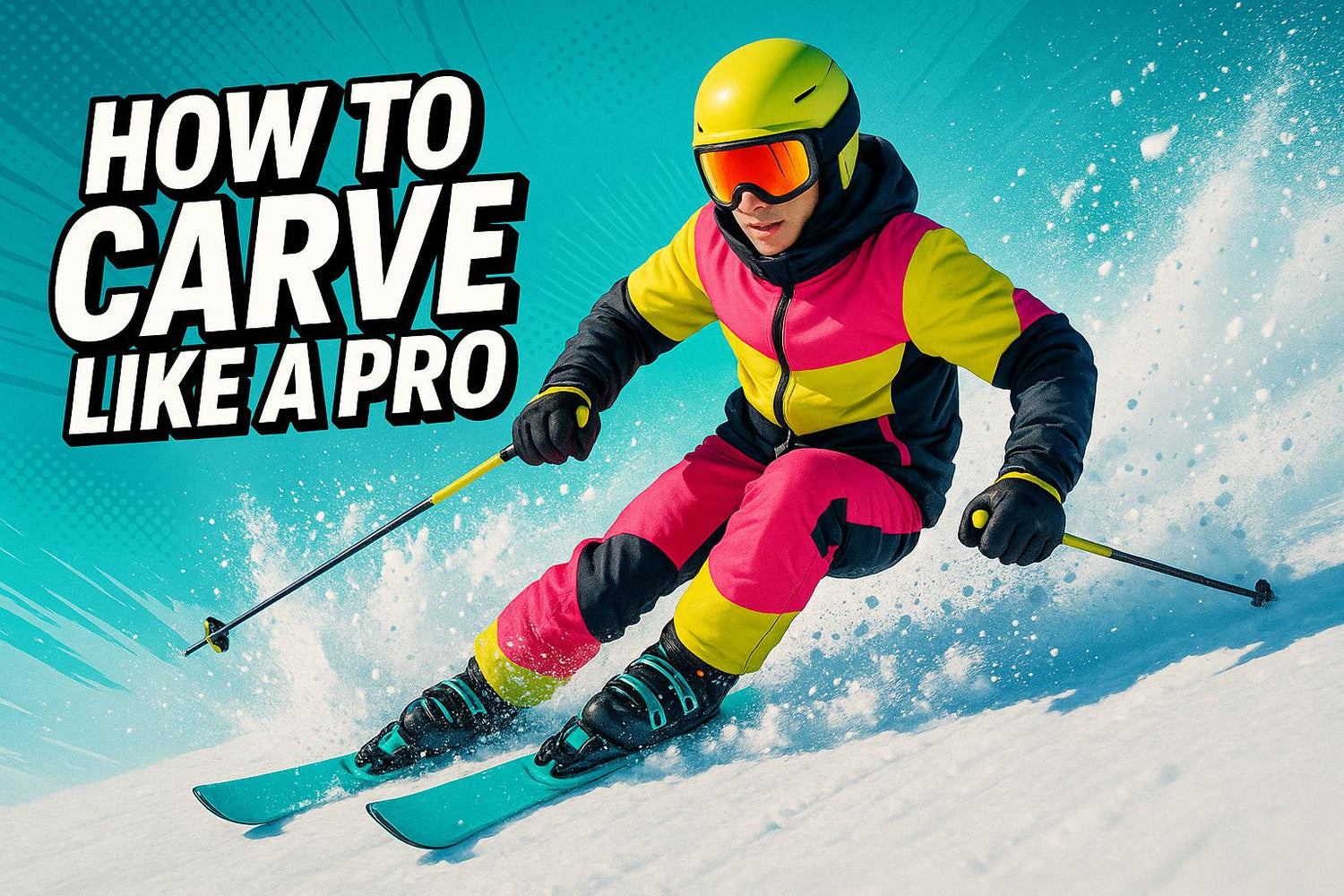
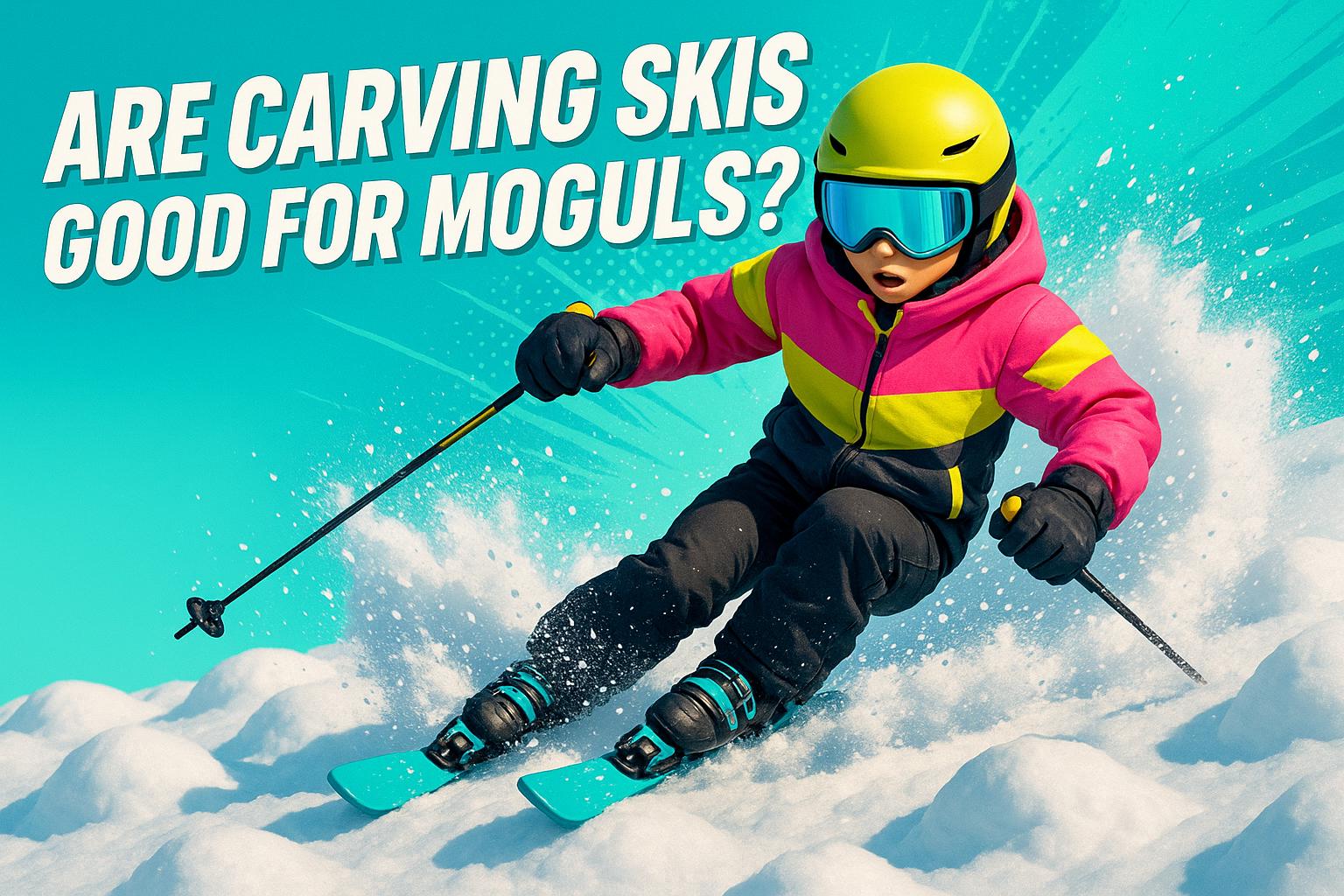



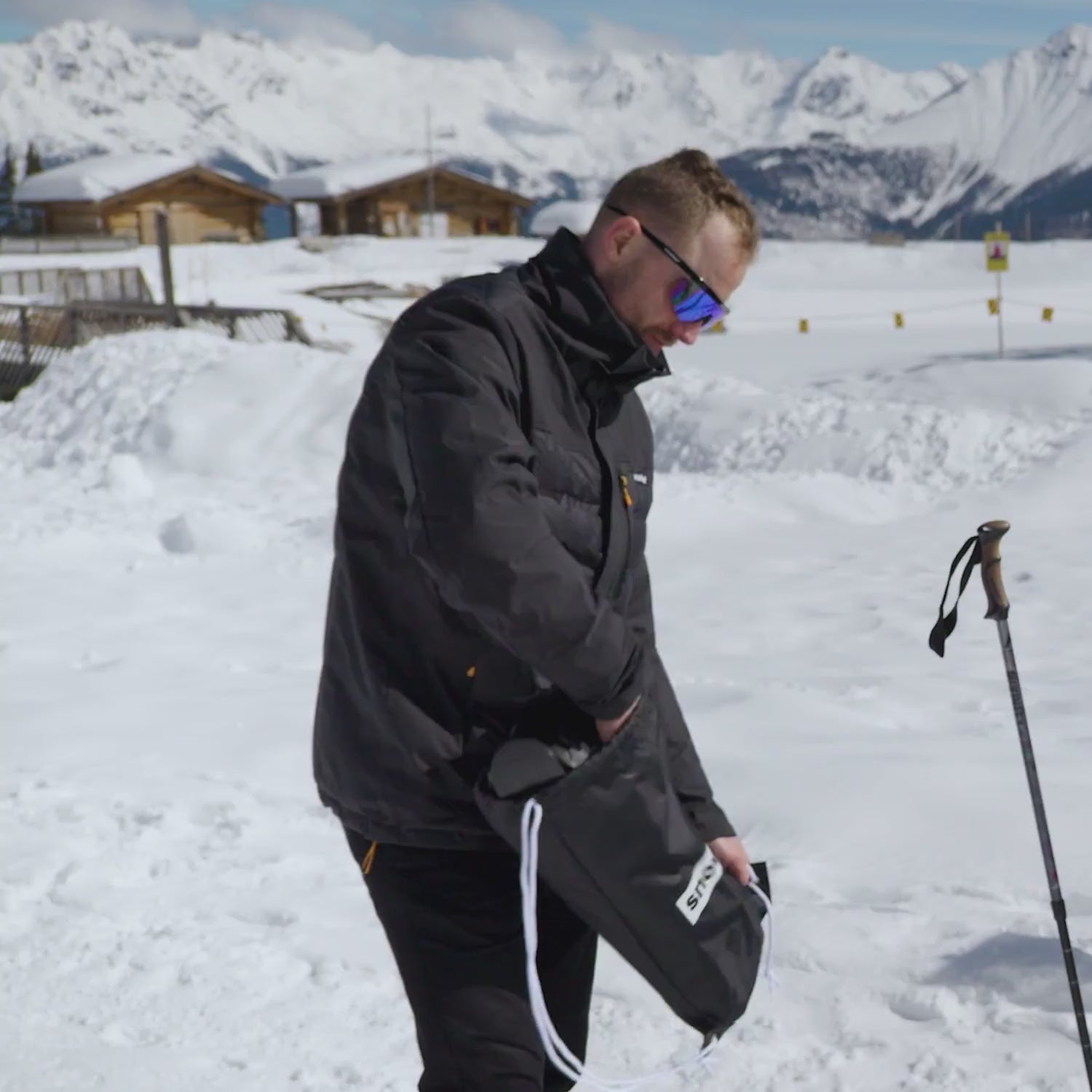

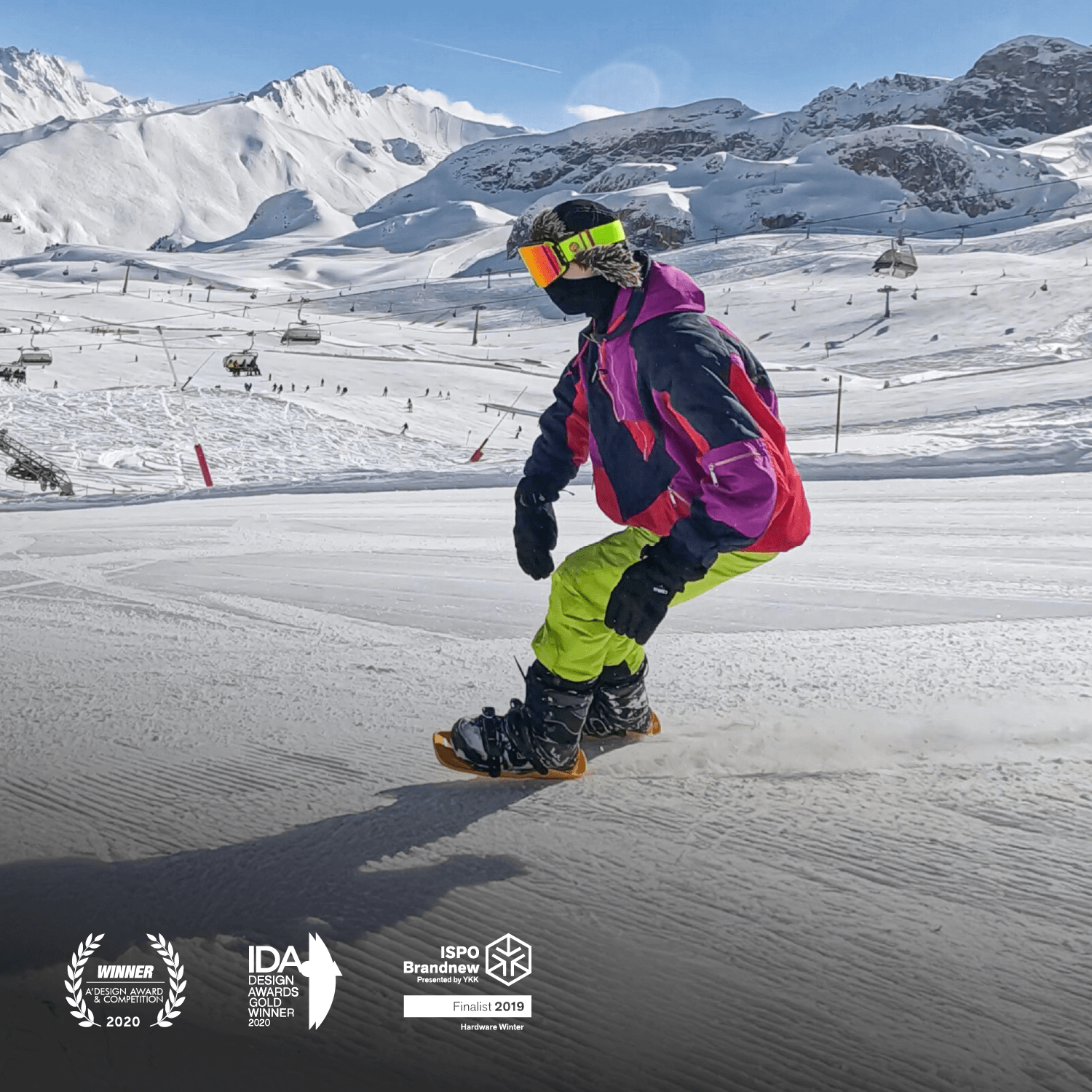
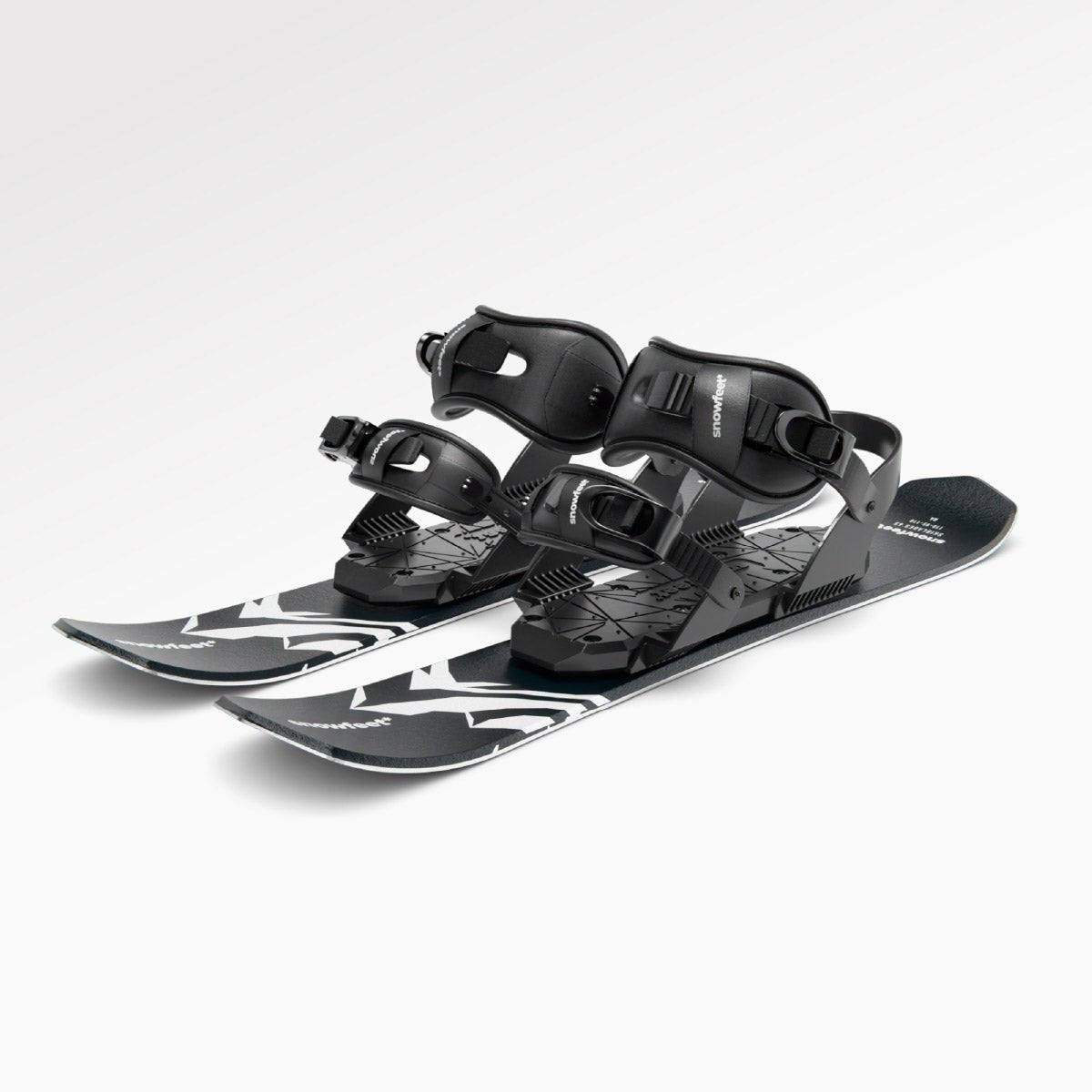
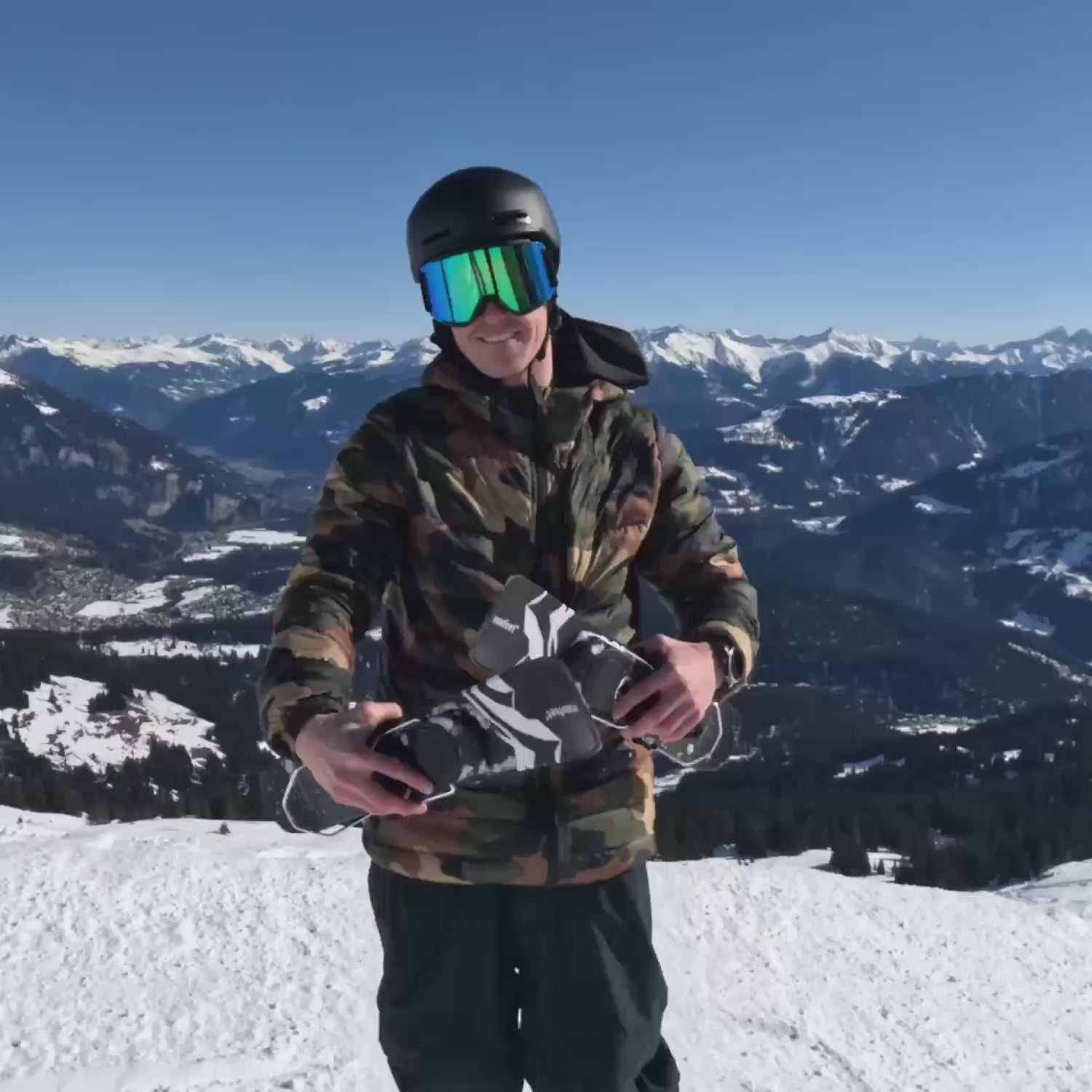
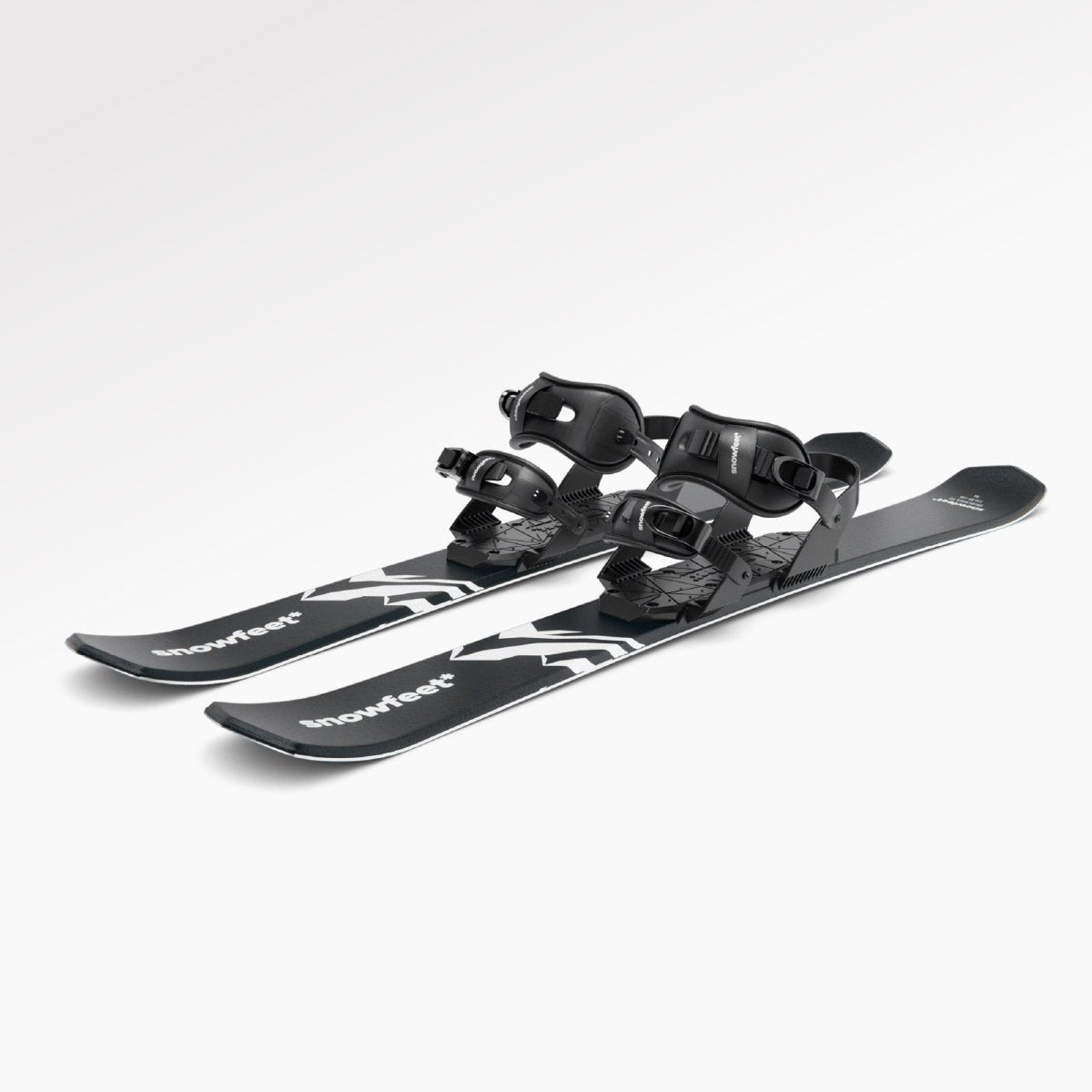
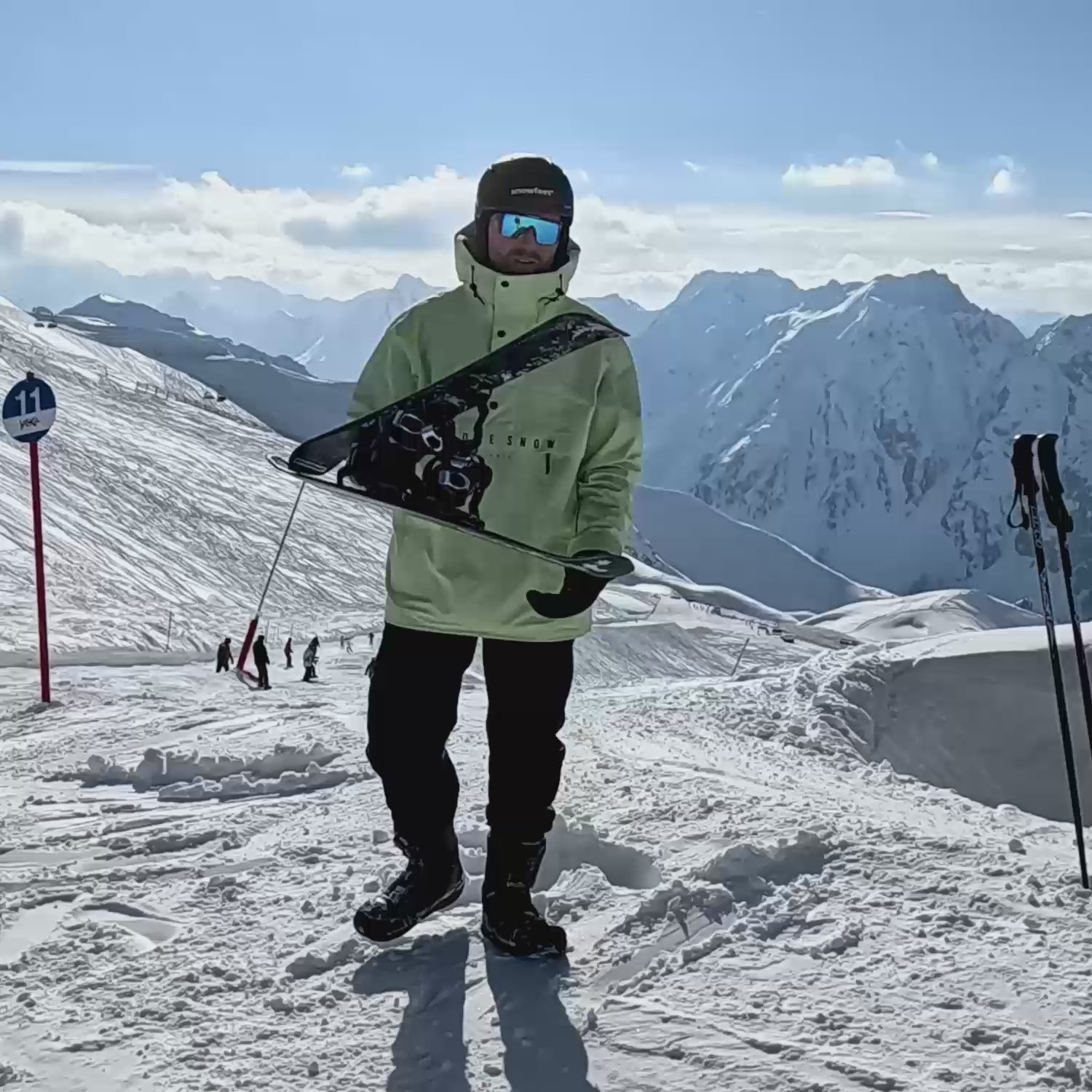
Zanechte komentář
Tento web je chráněn službou hCaptcha a vztahují se na něj Zásady ochrany osobních údajů a Podmínky služby společnosti hCaptcha.